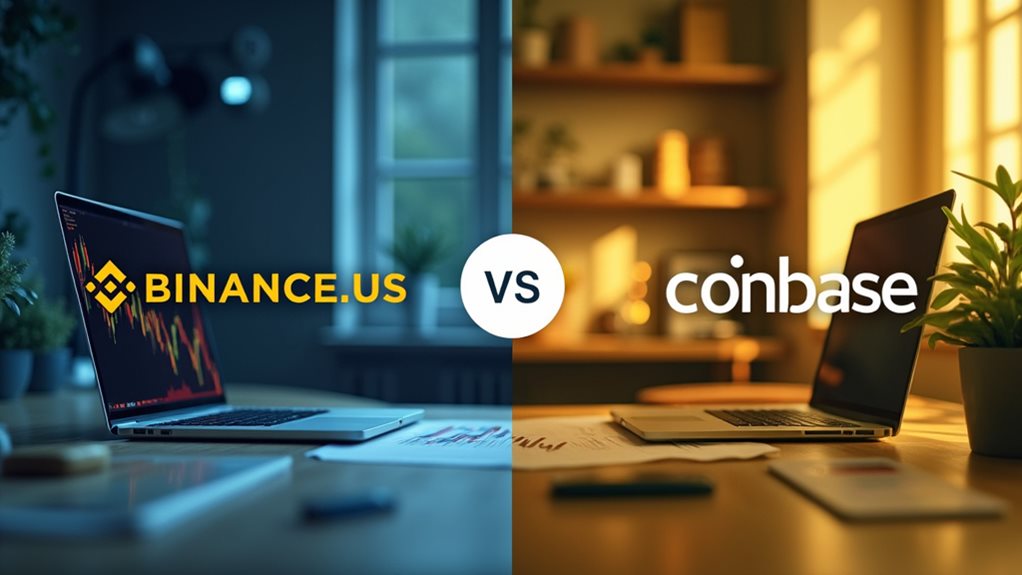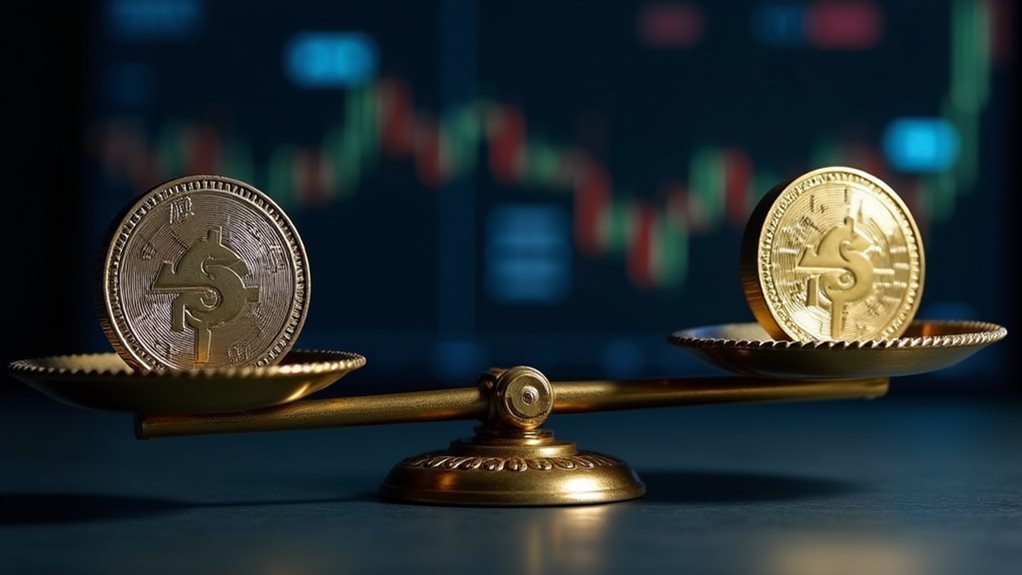Traders face a clear choice between these crypto heavyweights. Binance.US wins on fees, charging just 0.10% compared to Coinbase's steeper 0.6%. But Coinbase dominates in crypto selection with 240 coins versus Binance.US's 95. Beginner? Coinbase's simple interface makes crypto less scary. Advanced trader? Binance.US offers complex tools and BNB fee discounts. Both platforms meet U.S. regulations and security standards. The real differences emerge in the details.

While both crypto exchanges continue battling for US market dominance, Binance.US and Coinbase showcase stark differences heading into 2025. The fee structures tell a pretty clear story – Binance.US comes in hot with a mere 0.10% trading fee, while Coinbase users fork over up to 0.6%. Yeah, you read that right. For high-volume traders, Binance.US even offers zero maker fees. Coinbase? Not so much with the freebies. Users can get an additional 25% fee discount when paying with BNB coin on Binance.US.
Let's talk crypto selection. Binance.US offers about 95 coins – not exactly mind-blowing compared to big brother Binance's 600+ selection, but still respectable. Coinbase sits pretty with around 240 cryptocurrencies, mainly sticking to the mainstream stuff. Want to dabble in some obscure DeFi tokens? Better look elsewhere. With a massive 110 million verified users, Coinbase has established itself as a go-to platform for mainstream cryptocurrency adoption.
The user experience is where things get interesting. Coinbase wins the newbie-friendly contest hands down, with an interface your grandma could probably figure out. Binance.US? A bit more complex, but hey, at least it's streamlined for American users. Both platforms offer passive income opportunities through staking features. Both platforms throw real-time data and fancy charts at you, and Binance's got their Academy if you're feeling studious.
On the regulatory front, both exchanges play by Uncle Sam's rules – they kind of have to. Coinbase flaunts its publicly-listed status like a badge of honor, while Binance.US works overtime to prove it's not just its international cousin in a stars-and-stripes costume. Both face their share of regulatory side-eye, but they're still standing. Recent global regulations have created uncertainty for both platforms' operations in various jurisdictions.
Security's a mixed bag. Coinbase keeps 98% of user funds in cold storage – pretty impressive. Both platforms use two-factor authentication because, duh, it's 2025. But let's not forget Binance's awkward 2019 hack moment. That's like the crypto equivalent of an embarrassing high school yearbook photo.
Customer support tells the final tale. Coinbase offers the full menu – phone, email, chat. Binance.US keeps it simple with live chat and a help center. Both are established players, but their approaches couldn't be more different. It's like comparing a full-service restaurant to a food truck – both feed you, but the experience hits different.
The bottom line? These exchanges are like non-identical twins – same family, totally different personalities. Each has its strengths, each has its quirks, and neither is perfect. Welcome to crypto in 2025, folks.
Frequently Asked Questions
Which Exchange Offers Better Customer Support for Crypto Trading Emergencies?
Coinbase edges out Binance.US for emergency support, but let's be real – neither is winning any customer service awards.
Coinbase offers actual phone support (gasp!), which can be essential when crypto hits the fan.
Meanwhile, Binance.US throws users into the void of virtual assistants and ticket systems.
Sure, both platforms have detailed FAQs and security measures, but when trading goes sideways, Coinbase's direct contact options make it the lesser of two evils.
Can I Transfer Cryptocurrencies Directly Between Binance US and Coinbase?
Yes, cryptocurrencies can be transferred directly between Binance US and Coinbase.
It's pretty straightforward – users just need to copy and paste the correct wallet addresses between platforms.
Here's the kicker though: selecting the right network is essential. One wrong move and those coins could vanish into crypto oblivion.
Both exchanges make the process relatively simple, with clear interfaces for sending and receiving digital assets.
Do Both Platforms Support Automatic Recurring Crypto Purchases?
Binance.US clearly offers robust automatic recurring purchases – daily, weekly, or monthly options with various payment methods like ACH and debit cards.
It's a no-brainer for dollar-cost averaging fans.
Coinbase? Well, that's a bit murky. While they're generally user-friendly, specific details about their recurring buy features aren't explicitly laid out.
Both platforms prioritize security, but Binance.US takes the lead on automated purchase flexibility.
Which Exchange Has Better Integration With Hardware Wallets?
Coinbase takes the lead in hardware wallet integration.
Their dedicated wallet app plays nice with Ledger and Trezor, offering smoother management of assets across multiple networks.
Binance.US? They're more basic.
Sure, you can send crypto to hardware wallets, but there's no fancy integration. Just straight transfers.
While both exchanges support hardware wallets, Coinbase's user-friendly approach and detailed documentation make it the clear winner in this department.
Are There Differences in Withdrawal Processing Times Between the Platforms?
Withdrawal times vary considerably between the platforms.
Coinbase typically processes crypto withdrawals within minutes, while bank transfers take 1-3 business days.
Binance US can be slower, with crypto withdrawals taking up to several hours during high network congestion.
But here's the kicker – Binance US often has faster fiat withdrawals, usually completing ACH transfers within 24 hours.
Network conditions and verification levels affect both platforms' speeds.









